ROBIN WEEK: The best of the best…
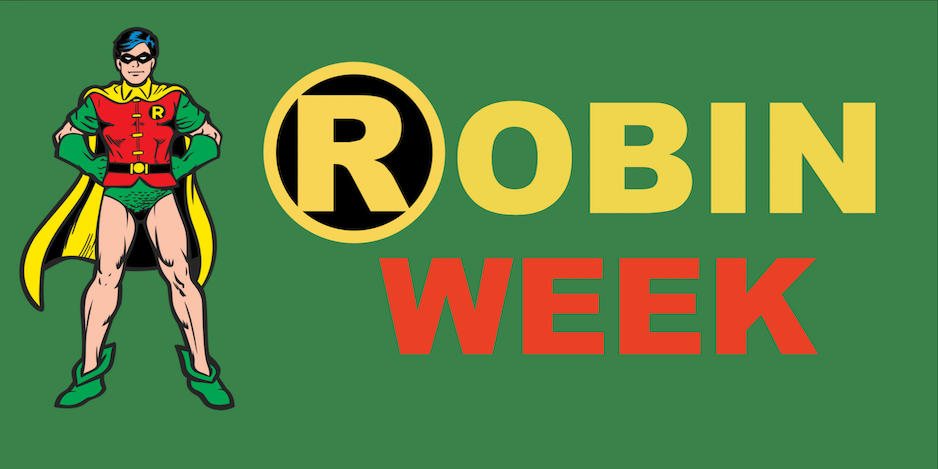
—
Welcome to ROBIN WEEK! One of the greatest heroes in comics history debuted 80 years ago this month — and we’re celebrating with a series of features saluting the Boys, Girls and Teens Wonder. For the complete index of features, click here.
—
Funny how things turn out sometimes. A year ago, for Batman’s 80th anniversary, we convened a blue-ribbon panel of experts — including Neal Adams and Paul Levitz — to pick the TOP 13 BATMAN STORIES EVER. (Click here. You’ll dig it.)
It’s not quite so simple to reach consensus on Robin, however, so for his 80th, I decided on a different tack: a singular point of view. Comics writer and 13th Dimension contributor Scott Tipton was up to the task and produced an outstanding list. Any Robin story in any medium was eligible — solo or otherwise. It could be nominally a Batman story, a Teen Titans story or a team-up — but Robin had to be the focal point.
Scott chose not to rank his choices. So with his agreement, I planned to rank them based on my own editorial judgment and add and subtract a few stories here and there. A mash-up, as Scott called it.
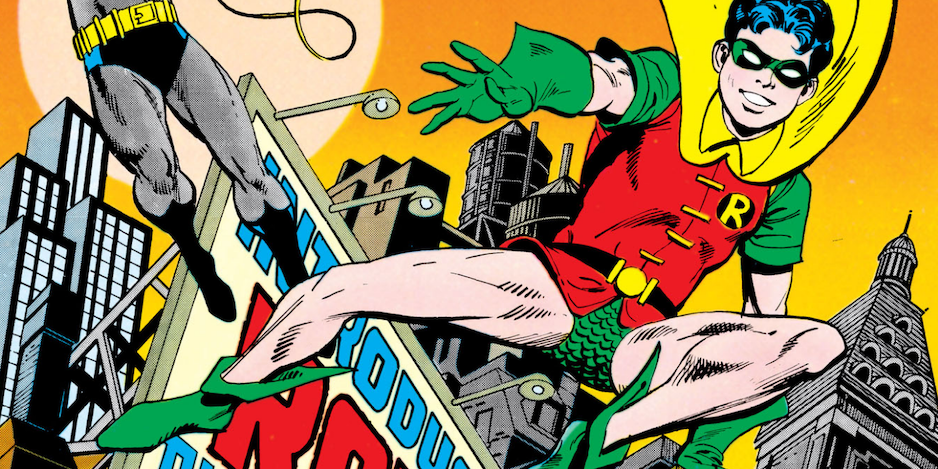
Then, when we announced ROBIN WEEK, editor/author/journalist/pop-culture historian Glenn Greenberg asked if he could take a crack at such a list.
And so, in the end, I took Scott’s list and Glenn’s list (which was in 13-1 order), made my own adjustments and came up with the TOP 13 ROBIN STORIES EVER — RANKED.
Ultimately, all three lists were quite different, so below the TOP 13, I’ve opted to break our own rules and include the also-rans, with full commentary. Kind of how we created 2019’s ULTIMATE BATMAN READING AND VIEWING GUIDE. (Click here. You’ll dig that too.)
Anyway, enough preamble. Here are the TOP 13 ROBIN STORIES EVER — RANKED:
—
13. Batman #416, White Gold and Truth, by Jim Starlin, Jim Aparo, and Mike DeCarlo (1988). Depicting the first meeting between Dick Grayson — now Nightwing — and the post-Crisis on Infinite Earths Jason Todd, this story went a long way toward reconciling the contradictions in Batman/New Teen Titans continuity that sprouted when DC decided to reimagine Jason’s origin. Initially wary of one another, a bond of sorts forms between the two young crimefighters — one that, unfortunately, is never able to deepen, given the events of A Death in the Family just a few months later. Incidentally, the DNA of this story can be seen in the Titans TV series on DC Universe. (Glenn’s top pick.)
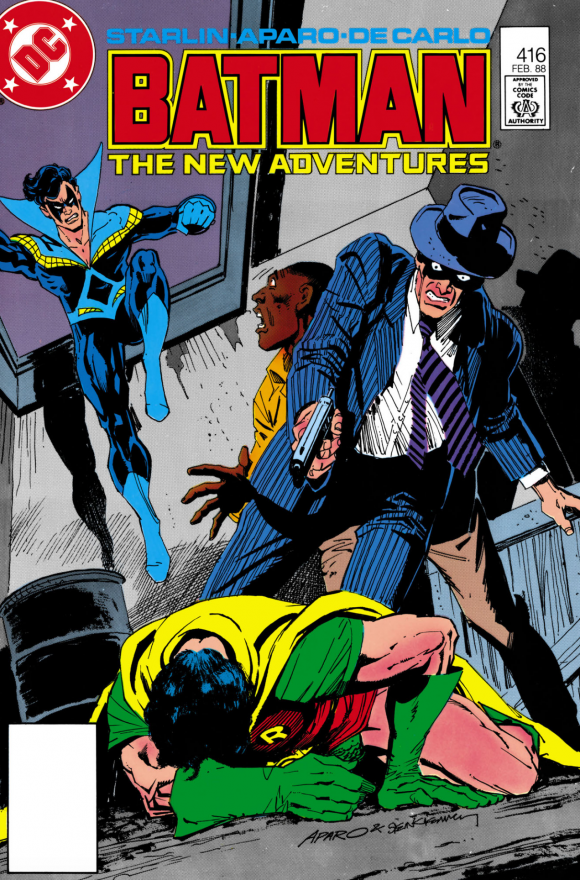
—
12. The New Teen Titans #38: Who is Donna Troy?, by Marv Wolfman, George Pérez and Romeo Tanghal (1984). This highly acclaimed classic is as much of a character-building story for Robin/Dick Grayson as it is for Wonder Girl, with Dick’s detective skills put to the test as he tries to piece together Donna’s complicated history. In the end, he shows that while Batman has had a profound influence on him, he’s become very much his own man. (Picked by Glenn.)
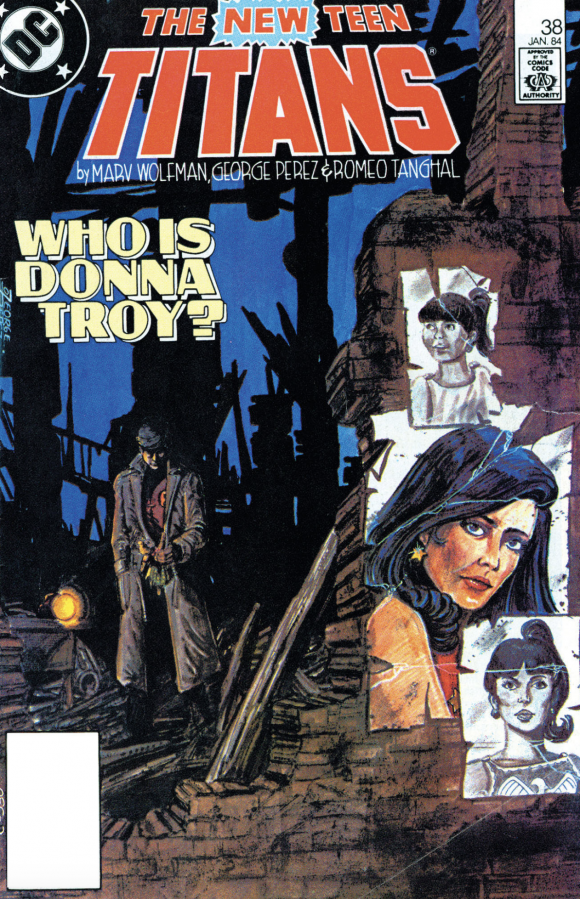
—
11. A Death in the Family, Batman #426-429, by Jim Starlin, Jim Aparo and Mike DeCarlo (1988-89). The infamous storyline that culminated in a call-in stunt to decide whether Robin lived or died, this is a wild, wacky, ludicrous, sloppy, and yet highly entertaining four-parter that sends the increasingly rebellious post-Crisis Jason Todd on an international quest to find his mother. This puts him on a collision course with the Joker, who — SPOILER ALERT — brutally murders Jason in a scene that undoubtedly delighted Robin haters far and wide. (Picked by Glenn. Dan adds: Like it or not, no list would be complete without this.)

—
10. Detective Comics #387: The Cry of Night Is — ‘Sudden Death!’, by Mike Friedrich, Bob Brown and Joe Giella (1969). The issue celebrated Batman’s 30th anniversary with a re-telling of Detective Comics #27’s The Case of the Chemical Syndicate, made modern (at the time) by Friedrich’s portrayal of hippie vs. square culture. Robin, representing law and order, is utterly convinced that the son of the murder victim is the killer, based largely on his own prejudices about the counterculture. Meanwhile, the hippie son takes an instant dislike for Robin and what he represents. The real killer is eventually revealed and Robin and the son each reach the conclusion that they have much to reconsider. It all sounds Afterschool Special-ish, but it’s an affecting character study of Batman’s sidekick not long before he would head off for Hudson University. (Picked by Dan.)
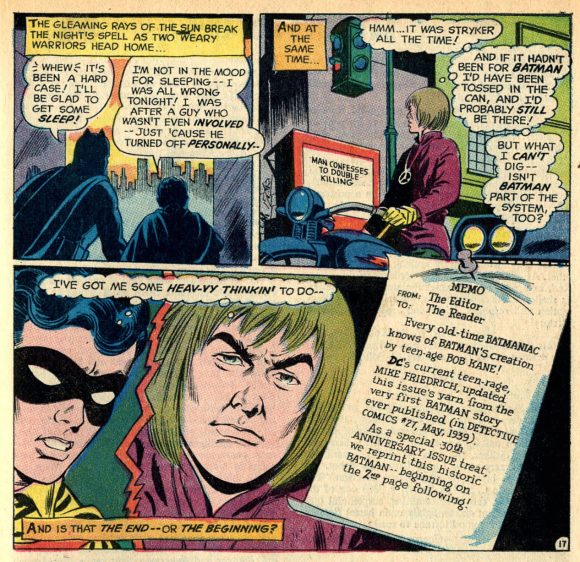
—
9. Teen Titans #14: Requiem for a Titan!, by Bob Haney and Nick Cardy (1968). The most startling Robin story up to that time, with gorgeous atmospheric art. The Boy Wonder has to stand alone against the Gargoyle, who tries to manipulate our young hero into throwing in the towel — even getting him to unmask in stunning fashion. One of the first stories to show Robin’s true dramatic potential, it remains a classic. (Picked by Dan.)
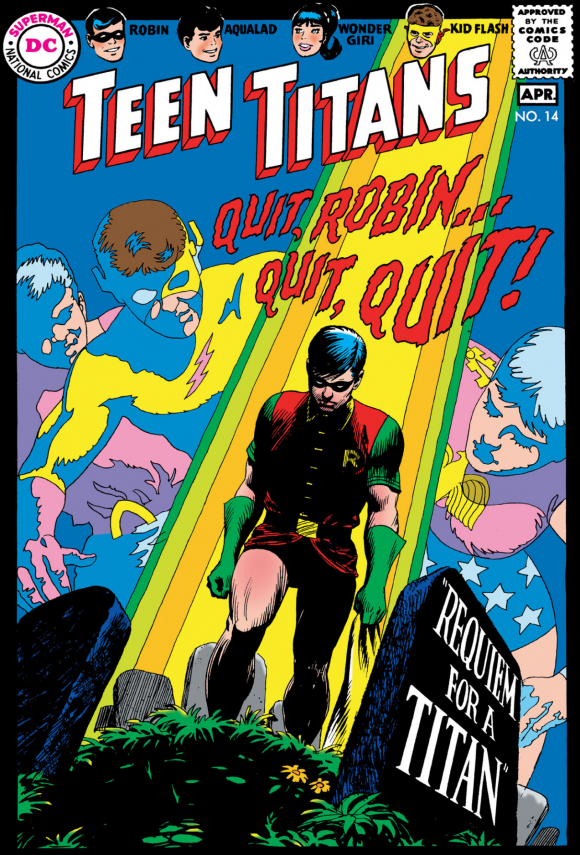
—
8. Detective Comics #526, All My Enemies Against Me!, by Gerry Conway, Don Newton and Alfredo Alcala (1983). This double-sized extravaganza featuring all of Batman’s major enemies on the loose — and Killer Croc on the rise — marks the final appearance of Dick Grayson as a regular cast member in the Batman books, with The New Teen Titans gaining full custody of the character. It’s also the original, pre-Crisis version of how Bruce Wayne took in Dick’s immediate successor as Robin, Jason Todd. Here, Jason’s origin is pretty much a copy of Dick’s — no stealing the tires off the Batmobile for this kid! (Picked by Glenn.)
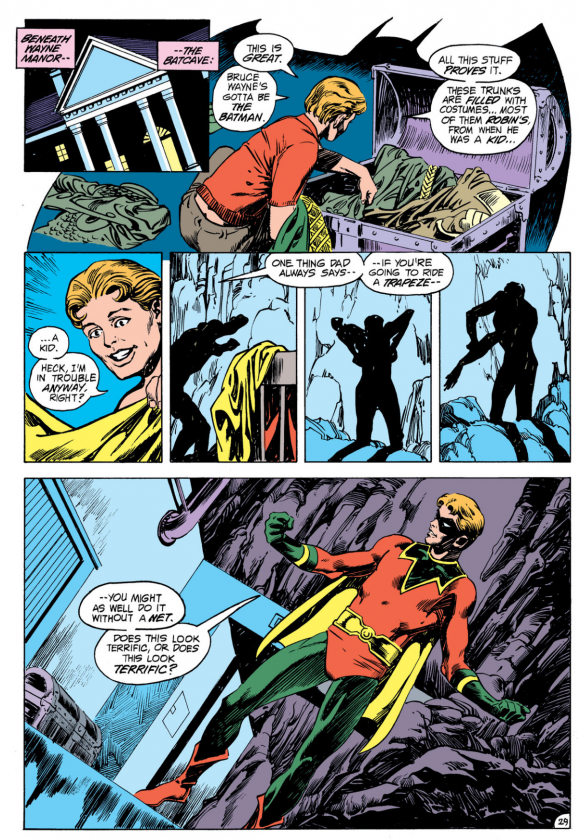
—
7. The New Teen Titans #1, by Marv Wolfman, George Perez and Romeo Tanghal (1980). The untitled debut issue of Wolfman and Perez’s soon-to-be-smash hit series really marks the beginning of Robin’s second act as an A-list DC character. It’s here that the character fully stepped out of Batman’s shadow, becoming the natural leader of a group of heroes who were all much more powerful than him; finding a mature romantic relationship for the first time with Starfire; and being fully portrayed as a young adult, with such success that Wolfman and Perez were eventually able to get him out of the same costume he’d worn since he was a child. (Picked by Scott.)
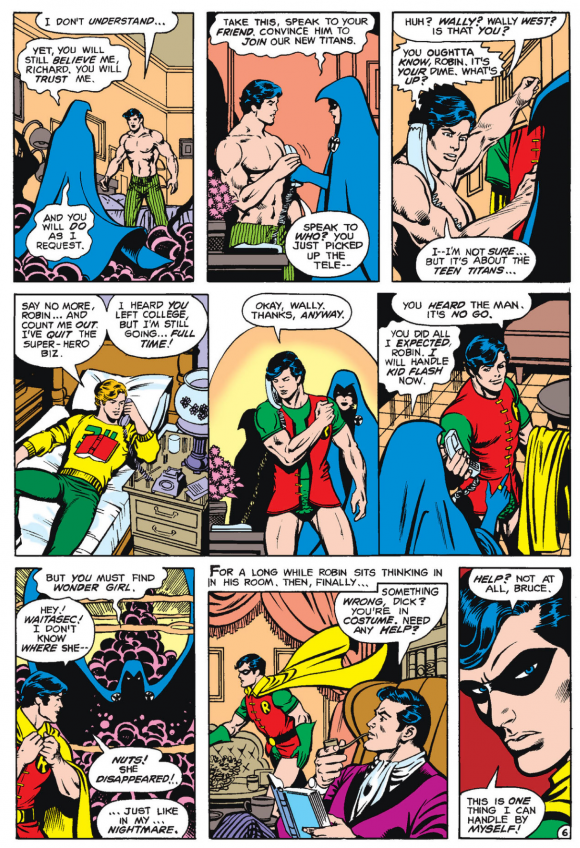
—
6. Robin: Year One, by Chuck Dixon, Scott Beatty, Javier Pulido and Robert Campanella, with Lee Loughridge (2000-01). By far the best look at the early days of Dick Grayson’s career. Writers Dixon and Beatty and artist Pulido show us how young Dick Grayson struggled through his first 12 months as Batman’s partner, contending with Alfred’s concerns, Commissioner Gordon’s misgivings, Batman’s doubts and an unholy beating at the hands of Two-Face. Great storytelling, and some of Dixon’s best work with the Dick Grayson character. (Picked by Scott.)
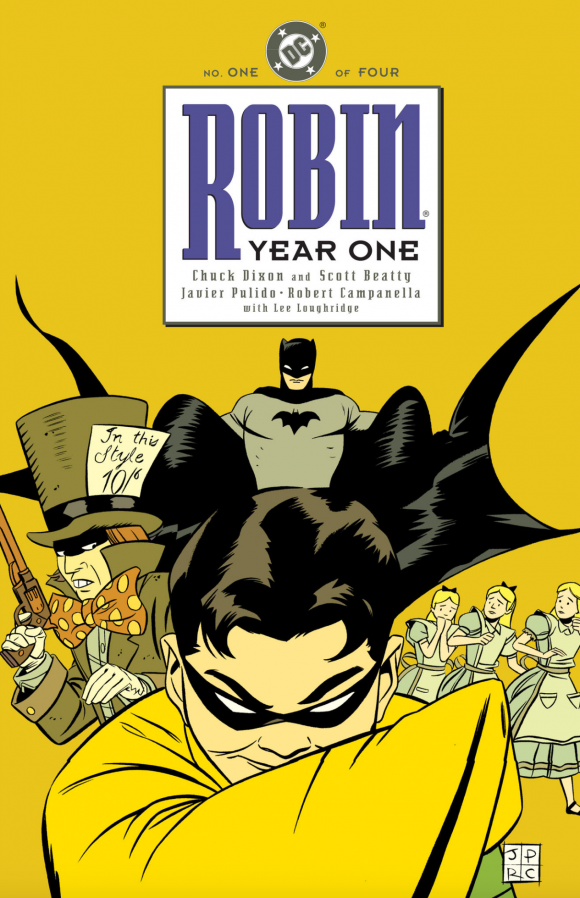
—
5. Batman Family #13: The Man Who Melted Manhattan!, by Bob Rozakis, Don Newton, Marshall Rogers and Bob Wiacek (1977). Robin, Batgirl and Man-Bat team up to take on Alfred’s evil alter ego the Outsider. This is a really zippy story that showcases the strength of Batman’s supporting cast — without the Darknight Detective on hand. But the topper is the moment when Robin finally confronts his feelings for Batgirl, a scene the series was building toward from the first issue. Dick’s soliloquy conveys the Teen Wonder’s growing maturity — a few years before Marv Wolfman and George Perez got their hands on him. (Picked by Dan.)

—
4. Batman ’66: The Joker Goes to School/He Meets His Match, the Grisly Ghoul (1966). The second appearance of Cesar Romero’s Joker on the series, this episode — written by Lorenzo Semple Jr. and directed by Murray Golden — finds the Clown Prince of Crime scheming to influence Gotham’s youth through gimmicked vending machines in the city’s high schools, providing viewers a rare look at Dick Grayson’s life outside the Batcave. But what really puts this episode over the top is Burt Ward’s hilarious performance as Dick going undercover to join the Joker’s gang of street toughs. (Picked by Scott and Dan, who adds: It’s probably Ward’s best scene in the entire series.)
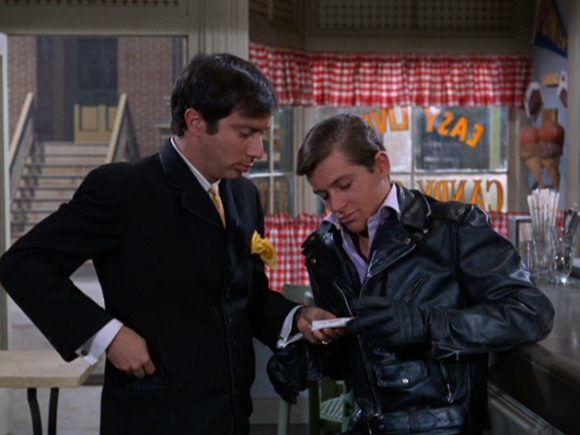
—
3. The Brave and the Bold #182, Interlude on Earth-Two, by Alan Brennert and Jim Aparo (1982). The Earth-One Batman finds himself transported to Earth-Two, where he encounters a Robin/Dick Grayson who is long past his “Boy Wonder” days and is now a fully grown, fully established crimefighter in his own right. There’s immediate friction between them — as awkward as it is for Batman to interact with an older, alternate version of his ward who doesn’t take kindly to being given orders, it’s even tougher for Robin, who is still haunted by the tragic death of his Batman some months earlier. Still, they must find a way to work together to stop a revenge-crazed Professor Hugo Strange from destroying Gotham City. (Picked by Glenn and Dan.)
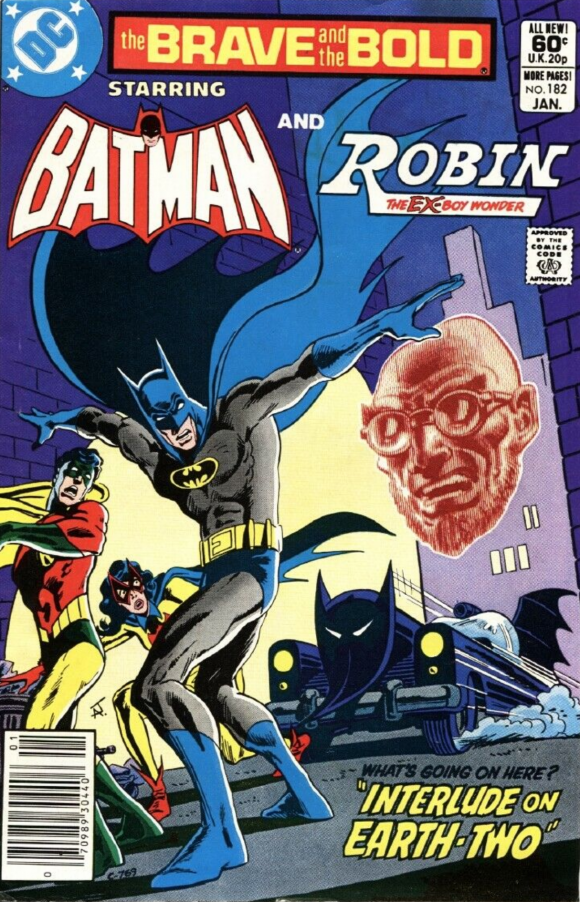
—
2. Detective Comics #38: The Sensational Character Find of 1940… Robin, the Boy Wonder, by Bob Kane, Bill Finger and Jerry Robinson (1940). This is obviously the one that started it all. And for a move designed to add some lightheartedness to the Batman strip, the story is surprisingly grim, as we see the murder of Dick Grayson’s parents at the hands of gangsters, and the young boy swear an oath to avenge their deaths alongside the Caped Crusader. (Picked by Scott and Dan.)
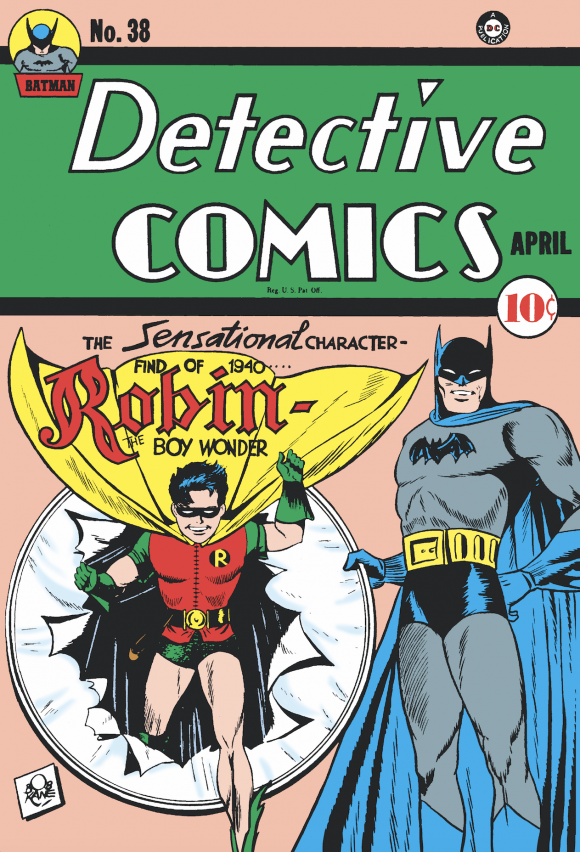
—
1. Batman Chronicles: The Gauntlet, by Bruce Canwell and Lee Weeks, with Matt Hollingsworth (1997). It could just as easily have been called “Robin: Day One.” Batman puts the Boy Wonder through his paces with a challenge: If Robin is able to evade the Dark Knight until sunrise in Gotham, he’ll graduate from his training and be allowed to join the Caped Crusader in his war on crime. Of course, Robin gets into all sorts of trouble along the way with a bunch of gangsters. It’s a taut thriller in the vein of Miller and Mazzucchelli’s Batman: Year One, but it has the effect of lightening things up enough to make the Masked Manhunter a bit softer — just as Detective Comics #38 did decades earlier. The creative team beautifully illustrates why Batman needs a Robin — and why Robin is a brilliant character in his own right. (Picked by Dan.)
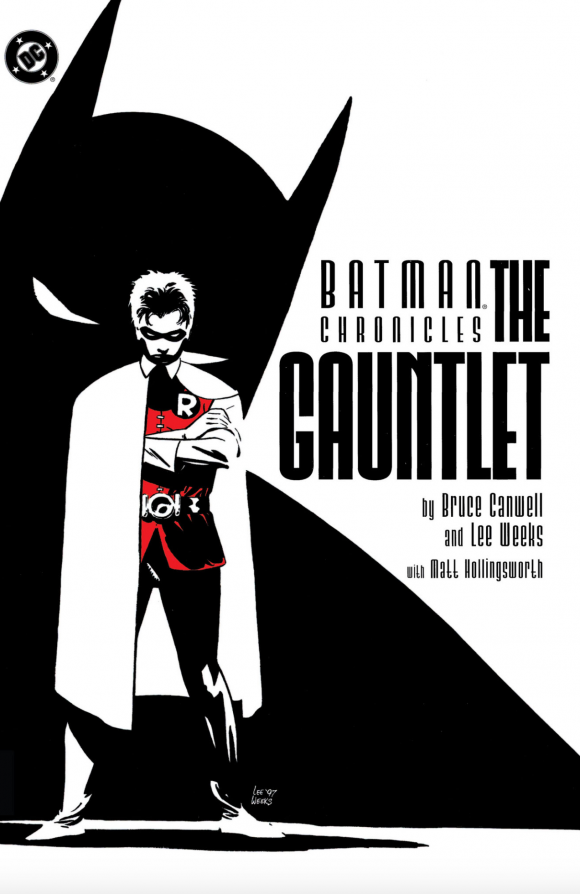
—
HONORABLE MENTIONS, in alphanumerical order:
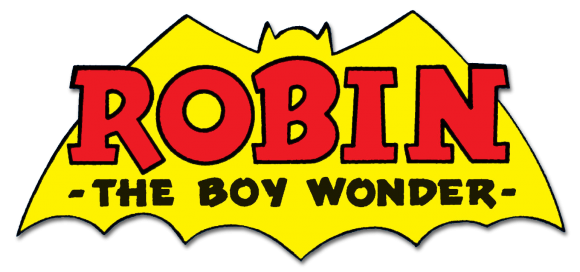
— The Adventures of Batman: Will the Real Robin Please Stand Up? (1968). This episode from the original Filmation series, written by Oscar Bensol, spotlights Robin and his doppelganger, who has fallen under the sway of Catwoman. It’s wonderfully hokey but, as with most Filmation ’68 cartoons, filled with downright groovy scenes like Fake Robin’s training sequence and his showdown with the real Boy Wonder. (Picked by Dan.)
— Batman #153: Prisoners of Three Worlds, by Bill Finger, Sheldon Moldoff and Charles Paris (1963). Batman comics were a whole other thing in the early ‘60s, with space aliens an almost common occurrence in Gotham City. Such was the case here in this odd but oddly sweet sci-fi tale from Finger and Moldoff, in which Robin and Bat-Girl (the original blonde version, Kathy Kane’s niece) are whisked away to another world, where they find danger, alien sucker-disc plants, and surprisingly, romance. (Picked by Scott.)
— Batman #246, How Many Ways Can a Robin Die?, by Frank Robbins, Irv Novick, Dick Dillin and Dick Giordano (1972). Batman is driven to desperation when he is forced by a murderous criminal to watch the apparent death of Robin over and over again, in a variety of grisly ways. Each time, it turns out to be a mannequin, but with Dick Grayson having gone missing, Batman knows it’s only a matter of time before his young ward is killed for real. While Robin himself doesn’t get to take part in the action, he’s all over this story, with Batman’s devotion to him front and center. Neal Adams provides the stunning cover that captures the story perfectly. (Picked by Glenn.)
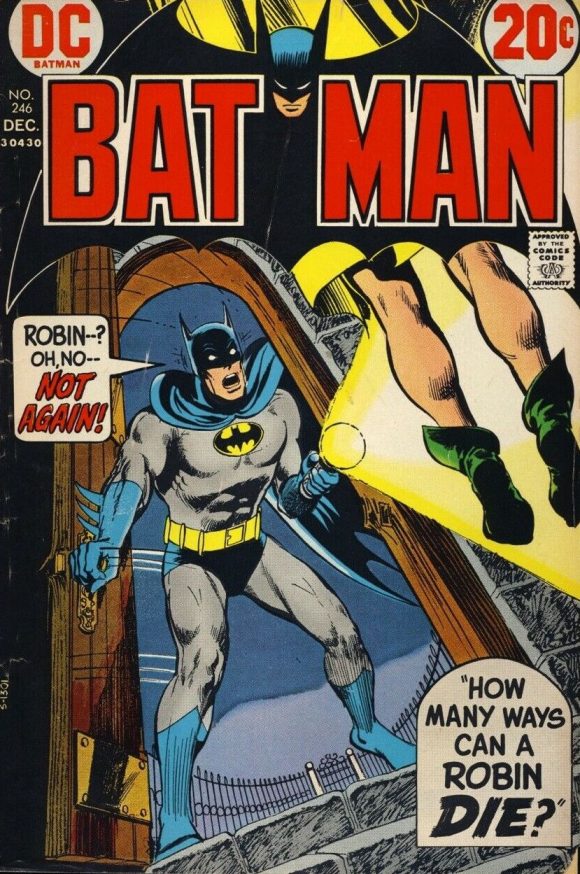
— Batman #252, The King From Canarsie!, by Elliot S! Maggin, Dick Dillin and Dick Giordano (1973). What would happen if Robin the Teen Wonder encountered acclaimed, legendary actor-singer-dancer-comedian Danny Kaye? The closest you’ll get to an answer is in this purely-for-fun back-up story, in which a character named Davy King — very obviously based on Kaye — decides to give up show business to get a college education. Naturally, he chooses Hudson University, where Dick Grayson is a student. When King is plagued by a series of suspicious-looking accidents, it’s up to Robin to find out who’s responsible, with in-jokes aplenty along the way. (Picked by Glenn.)
— Batman #337-339 and #341-344 by Gerry Conway, Don Newton, Irv Novick, Trevor Von Eeden, Gene Colan, Larry Mahlstedt, Steve Mitchell, Mike DeCarlo, Frank Chiaramonte and Klaus Janson (1981-1982). In a series of back-up stories, Dick Grayson/Robin, estranged from Bruce Wayne/Batman, hits the road on a journey of soul searching that takes him back to his roots in the circus (picking up on some continuity established in DC Comics Presents #31), pits him against a cult of demon-worshippers, and ultimately leads him to the realization that home is where the heart is. The storyline culminates in Batman #344, with Robin returning to Gotham City just in time to help an on-the-ropes Batman take down an ascendant Poison Ivy — and deciding that, at least for the time being, his place is at his mentor’s side. (Picked by Glenn.)
— Batman #349, Blood Sport, by Gerry Conway, Gene Colan and Alfredo Alcala (1982). Perhaps the darkest, most disturbing story ever to star Robin, certainly the Dick Grayson version. In this foray into full-on horror, Robin discovers the true nature of his new, mysterious girlfriend, Dala — and with Colan drawing it, you have a clue right there on what the lethal lady has been hiding about herself. (The full “Dala” storyline ran in Detective Comics #511-518 and Batman #345-351.) (Picked by Glenn.)
— Batman #368, A Revenge of Rainbows, by Doug Moench, Don Newton and Alfredo Alcala (1984). After months of buildup, and a tease involving a new costume and a stream of possible new names—including Bluejay, Domino and even Nighthawk—the pre-Crisis on Infinite Earths Jason Todd officially takes on the role of Robin. Dick Grayson, not yet Nightwing, shows up for a cameo and bequeaths Jason the iconic uniform in a scene both historic and touching. (Picked by Glenn.)
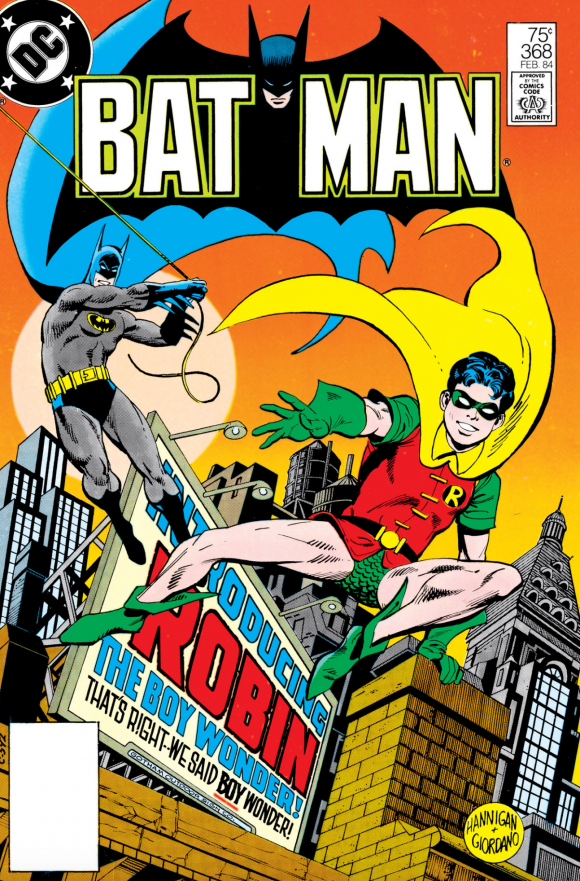
— Batman #424 and #425, The Diplomat’s Son and Consequences, by Jim Starlin, Mark Bright and Steve Mitchell (1988). The seeds are planted for the downfall of the post-Crisis Jason Todd, as he becomes more rebellious, reckless, and prone to violence. In this storyline, Robin goes after an ambassador’s son who sexually assaulted a woman in Gotham but is protected by diplomatic immunity. When the man falls from his penthouse balcony to his death, with Robin found on the scene, Batman has to consider the possibility that Jason was directly responsible — and must contend with the vengeance-thirsty ambassador himself. (Picked by Glenn.)
— Batman #442: A Lonely Place of Dying, Chapter 5: Rebirth, by Marv Wolfman, George Perez and Jim Aparo (1989). Writers Wolfman and Perez and artist Aparo return Robin to Batman’s side here properly, as Tim Drake becomes the third boy to wear the yellow cape and pixie boots, following the murder of Jason Todd at the hands of the Joker (or more precisely, at the hands of bloodthirsty readers who didn’t care for how DC had made Jason such an unlikable jerk). (Picked by Scott.)
— Batman #465: Debut, by Alan Grant, Norm Breyfogle, and Steve Mitchell (1991). Having completed months of rigorous training, earned his own version of the Robin uniform (designed by the eminent Neal Adams), and starred in his own limited series, Tim Drake officially takes his place at Batman’s side. A relatively low-key story, but it does a great job establishing the strong, supportive relationship between Batman and his new Robin, providing a stark contrast to the latter part of the Jason Todd era. (Picked by Glenn.)
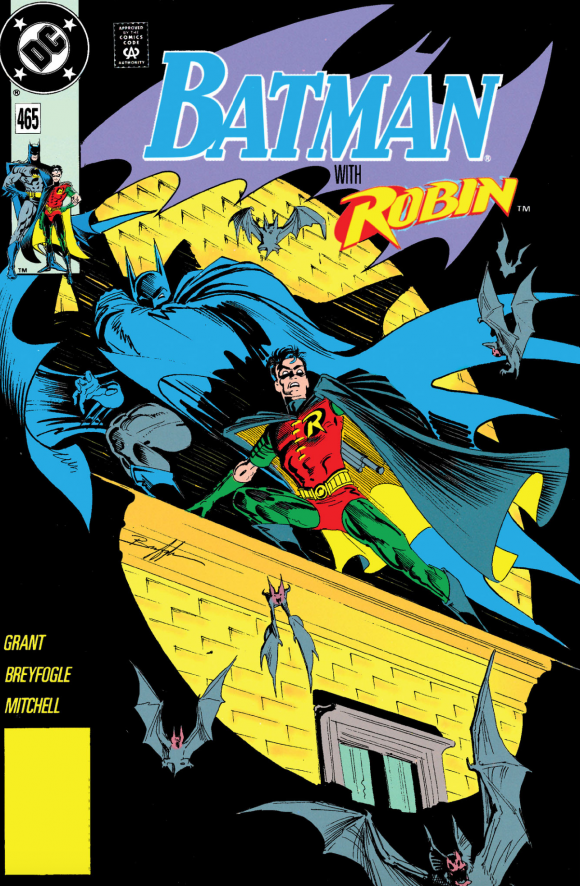
— Batman: Dark Victory, by Jeph Loeb and Tim Sale (1999-2000). This superior sequel to Loeb and Sale’s The Long Halloween doubles as a Dick Grayson origin story — and can live in the same universe as The Gauntlet and Robin: Year One. (Picked by Dan.)
— Batman Family #11: Till Death Do Us Part!, by Bob Rozakis, Curt Swan and Vince Colletta (1977). Growing up, I was a big fan of the “Dynamite Duo” Batgirl and Robin team-up stories in Batman Family, and this issue was always my favorite. First of all, there’s nothing better than Robin’s tuxedo on the cover. And there was always this sly undercurrent that there was something going on between Dick and Babs, as in this issue where they’re hanging out unmasked having coffee in Barbara’s apartment after the phony wedding. (Picked by Scott.)
— Batman: The Animated Series: Robin’s Reckoning (1993). Robin’s origin gets the animated treatment here, in this Emmy-winning episode from scripter Randy Rogel and director Dick Sebast. To their credit, the producers don’t pull their punches here, with the murder of the Flying Graysons portrayed in a fashion that’s all the more chilling in its subtlety. In a series full of brilliant casting, Back to the Future’s Biff himself, Tom Wilson, delivers the most perfectly hateable performance as Tony Zucco, the murderer of Dick’s parents. (Picked by Scott.)
— Batman: The Brave and the Bold: The Color of Revenge! (2009). After nearly a full season of Batman teaming up with just about every other DC character, Robin finally gets the spotlight here, in a tale — written by Todd Casey and directed by Michael Chang — about the now-grown Dick Grayson, on his own in Bludhaven, facing off against a revenge-seeking Crazy Quilt. Extra points for using both Robin’s 1970s motorcycle and his Earth-Two costume. (Picked by Scott.)
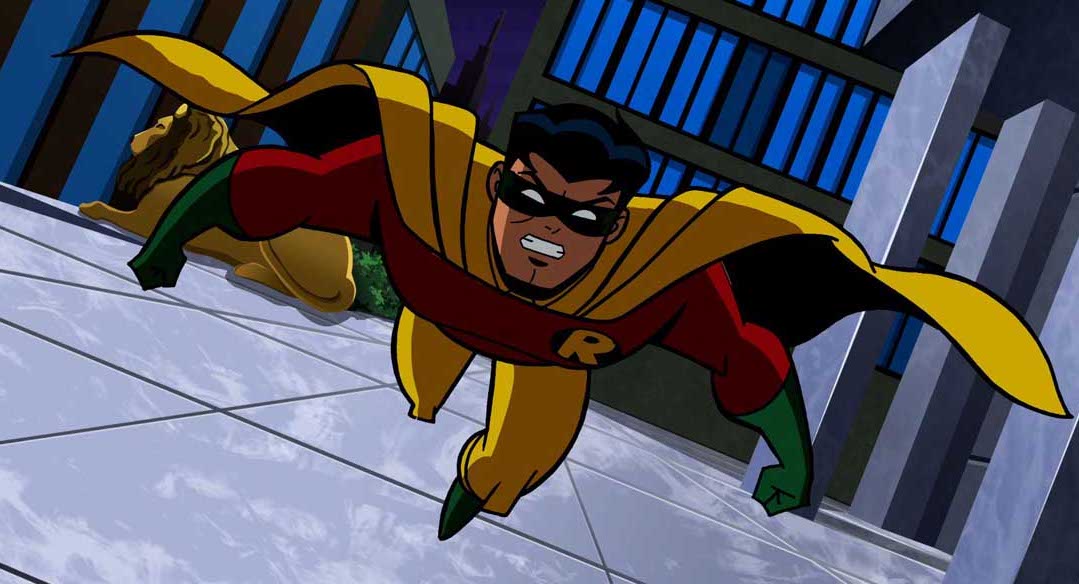
— DC Comics Presents #31, The Deadliest Show on Earth!, by Gerry Conway, José Luis García-López and Dick Giordano (1981). In this beautifully illustrated tale, Dick Grayson/Robin teams up with Superman to take on a traveling circus that has fallen under the control of a mysterious figure with mind-control abilities. Though they shared many adventures — usually with Batman — in World’s Finest Comics, it’s interesting to see Dick and Superman working together one on one, with the Dark Knight nowhere in sight and Robin able to shine as a crimefighter in his own right in front of the Man of Steel. The story is also notable for introducing the character of Waldo the Clown, a figure from Dick’s past, who would eventually appear on a recurring basis in the Batman books. (Picked by Glenn.)
— Infinity, Inc. #6: Divide – and be Conquered!, by Roy Thomas, Dann Thomas, Jerry Ordway and Al Gordon (1984). This one’s pretty dark. Set in the pre-Crisis days of Earth-Two, all the Justice Society members, including Robin, have mystically “drowned” in the Stream of Ruthlessness and turned evil, while still retaining their own personalities. Accordingly, Dick Grayson is consumed with a thirst for revenge on Boss Zucco, who lies helplessly dying in a prison hospital, with only Dick’s “sister” the Huntress stopping Robin from becoming a murderer, no better than Zucco himself. A rare look at how intense and vicious Robin could be if he wanted to. (Picked by Scott.)
— The New Batman Adventures: Old Wounds (1998). We finally learn why Dick Grayson left Batman’s side as Robin in this tense, moody animated episode from scripter Rich Fogel and director Curt Geda. Secrets are revealed and confidences betrayed. Extra points for excellent voice acting from longtime Dick Grayson Loren Lester. (Picked by Scott.)

— Superman Annual #11: For the Man Who Has Everything, by Alan Moore and Dave Gibbons (1985). Most people might think of the Moore/Gibbons classic as a Superman story, but I’ve always loved it for how it gave Jason Todd the greatest victory of his sad, short career, saving Superman, Batman and Wonder Woman from certain death at the hands of an intergalactic despot. If Alan Moore had gotten to write for Jason Todd more than once, readers never would have voted to kill him. (Picked by Scott.)
— The Uncanny X-Men/The New Teen Titans: Apokolips… Now, by Chris Claremont, Walt Simonson and Terry Austin (1982). You might not think of this epic DC/Marvel crossover by Claremont and Simonson as a Robin spotlight, especially with so many other characters to feature, but what really comes across here is the Teen Wonder’s importance as a leader and a strategist, as he confers with Professor Xavier and co-leads the combined teams alongside Cyclops. Thanks to Claremont’s words and Simonson’s body language, you never doubt him for a minute. Of course Robin is in charge. (Picked by Scott.)
—
MORE
— The ROBIN WEEK Index of Features. Click here.
— The TOP 13 ROBIN COVERS Ever — RANKED. Click here.

March 12, 2020
Fantastic list(s), gentlemen. Some of my very favorite comic stories listed here as well as the SINGLE favorite issue of all time, B&B #182. Bravo!!!
March 12, 2020
Thanks, Chris!
March 12, 2020
Robin’s celebration continues pretty well.
March 12, 2020
Dude, you missed Batman #213. The best telling of his origin with art by Andru & Esposito.
https://www.catspawdynamics.com/celebrating-the-80th-anniversary-of-robin-the-boy-wonder/
March 12, 2020
I would also throw into the mix Justice League of America issues 91 and 92 (First series), where the Robins of Earths 1 and 2 team up as a major part of the crossover–E1 Robin even gets to try on a costume later adapted in the later All-Star Super Squad stories.